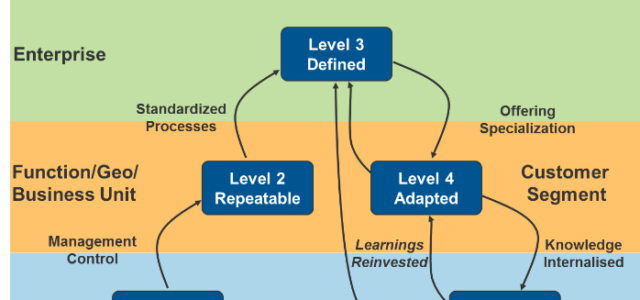Renowned strategist and business guru, Michael Porter boiled down strategy to two options: 1. Do what everyone else is doing (but spend less money doing it). 2. Do something no one else can do.
Harvard Business review’s work: “What is Strategy, again?” by Andrea Ovans offers a unique perspective to Porter’s framework by unpacking how those two options are not economically equivalent.
Paraphrasing Ovans: competing by doing what everyone else is doing (competing on price) means the pie shrinks and profitability declines for the entire industry. Ovans proposes that strategic focus should focus on 3 things:
1. Doing something new (resting on Porter’s 2nd point)
2. Building on what you already do
3. Reacting opportunistically to emerging possibilities
Ovans 2nd option has sadly been overly adopted and grossly misapplied for at first glance, it’s seemingly simple but in context of digital, is largely irrelevant (if again, applied improperly). This improper application glares out at marketers when you simply search for “what is digital strategy”, you read: “A digital strategy is often characterized by the application of new technologies to existing business activity” (Wikipedia / Accenture)
Take special note of the last part of this definition: “to existing business activity”.
Industry giants have spent millions collecting data on digital’s success record (when they simply apply new technology to existing business activity) and the results are grim:
- Forbes points out: “only 32% of brand marketers believe they’re executing an effective digital strategy.”
- Accenture Digital’s study on digital showed that only 45% of business executives interviewed believe their digital programs will achieve business objectives
- Sapient’s national online digital survey shows that nearly 50% of brands switched marketing agencies (or plan to in the next 12 months) for one with greater digital knowledge or, have hired additional digital specialists to handle digital work.
This bleak reality is no more poignantly shown than through Forrester’s digital engagement study where they evaluated 11.8 million user interactions against the top 50 global brands (including the likes of Nike, Apple, IBM, Toyota, etc.). Although follower counts have skyrocketed over the past years (top brands now average 18.1 million Facebook fans each; over 1 million on Instagram and follower counts have nearly doubled on Twitter and Google+) interaction rates from these followers are plummeting:
- Instagram’s interaction rate is barely half of what it was in 2014
- Per-follower interaction rates on Pinterest, Google+ and Twitter also all fell
- Facebook’s rates went slightly up (but Forrester attributes that to paid promotion) and since then, have fallen to -20% (Buzzsumo)
What does this actually tell us?
Three key things:
1. Marketers and brands are chasing any digital tactic of the day in response to the demands of digital preference but to limited affect because they’re simply applying digital to “existing business activity”.
2. Digital content saturation is making the digital space very noisy but consumers are not listening or more importantly, not engaging.
3. Forrester’s data on follower trends prove customers want to engage but marketer’s approaches of digital application (again, to existing activities) are missing the mark.
Applying strategy correctly in today’s digital world:
As strategy always seeks to answer the “how” of any business challenge, marketers must look at “what” is trying to be achieved through digital? For simplicity sake, the end goal (the what) of a marketer is to bring a consumer or potential consumer into a relationship with a brand for the sake of awareness, engagement, and ultimate conversion.
Addressing then the “how” and applied directly to today’s digital-business world, Robert Goffee and Gareth Jones in their key leadership work titled: “Why Should Anyone be Led by You?” underline how: “the most destructive existing force operating in institutions is something called technical rationality – that is, rationality without morality.” Manifesting this into operations, it becomes exceedingly frightening “for the efficiencies and capacity to dehumanize people.”
At the forefront then of a marketer’s strategic leadership paradigm must be a concentrated effort to “humanize” the brand. This results in an unwavering effort of customer-centric actions regarding how a brand interacts with an audience.
Insightfully, in 2009, Christine Huang, then head of cultural trends at GlobalHue, said: “Expect to see more brands rising to the challenge of understanding consumers; Brands MUST harness social culture.” Regrettably, brands have not strategically harnessed social culture and 7 years later in 2016, Douglas Holt yet again offers strong advice in his “Branding in the Age of Social Media” work where he says: “companies need to shift their focus away from the platforms themselves [tactics of YouTube, Facebook, etc.] and toward the real locus of digital power [the consumer].”
Holt’s work empirically demonstrates that brands must stop being bureaucratic whereby they: “excel at coordinating and executing complex marketing problems across multiple markets around the world…this organizational model leads to mediocrity when it comes to cultural innovation [customer-centric engagement].” Brands then must “leapfrog the conventions of their categories to champion new ideologies that are meaningful to customers.”
Simply put, brands are only successful in today’s digital world if they embrace a customer-centric, analytic 3.0 strategic approach and philosophy towards their desired target audiences.
“The web and new media give you the opportunity to reveal the human side of your business. Not in the last 50+ years has the balance of business interaction and communication been so in favor of personal interaction.” – Trust Agents, Chris Brogan
Full circle: marketers better listen to Michael Porter’s advice: Do something new.
Because what’s being done, just isn’t working.
Kevin Adema is an internationally awarded marketer, digital strategist, EventTechHub global top 500 keynote speaker and author of the Direct Marketing Association of Canada’s Mastering Digital Strategy certification program.
Article by channel:
Everything you need to know about Digital Transformation
The best articles, news and events direct to your inbox
Read more articles tagged: Featured, Innovation, Strategy







